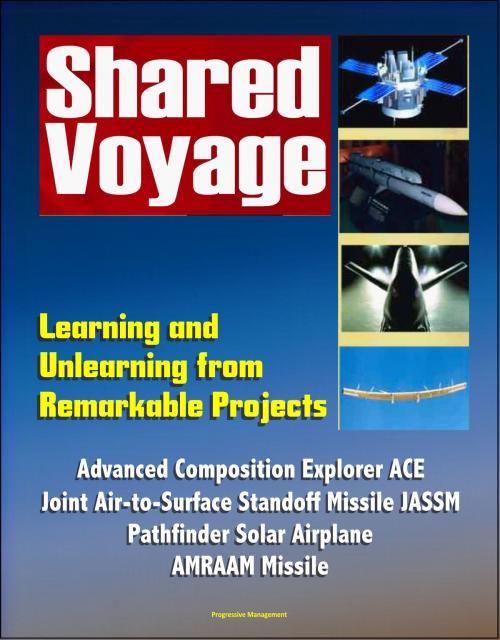Shared Voyage: Learning and Unlearning from Remarkable Projects - Advanced Composition Explorer ACE, Joint Air-to-Surface Standoff Missile JASSM , Pathfinder Solar Airplane, AMRAAM Missile
Nonfiction, Science & Nature, Technology, Aeronautics & Astronautics, History, Military, Aviation| Author: | Progressive Management | ISBN: | 9781310049200 |
| Publisher: | Progressive Management | Publication: | May 3, 2015 |
| Imprint: | Smashwords Edition | Language: | English |
| Author: | Progressive Management |
| ISBN: | 9781310049200 |
| Publisher: | Progressive Management |
| Publication: | May 3, 2015 |
| Imprint: | Smashwords Edition |
| Language: | English |
Professionally converted for accurate flowing-text e-book format reproduction, this NASA report is about four remarkable projects: the Advanced Composition Explorer (NASA), the Joint Air-to-Surface Standoff Missile (U.S. Air Force), the Pathfinder Solar-Powered Airplane (NASA), and the Advanced Medium Range Air-to-Air Missile (U.S. Air Force). Each project is presented as a case study comprised of stories collected from key members of the project teams. The stories found in the book are included with the purpose of providing an effective learning source for project management, encouraging the unlearning of outdated project management concepts, and enhancing awareness of the contexts surrounding different projects. Significantly different from project concepts found in most project management literature, Shared Voyage highlights concepts like a will to win, a results-oriented focus, and collaboration through trust. All four project teams researched in this study applied similar concepts; however, they applied them differently, tailoring them to fit the context of their own particular projects. It is clear that the "one best way" approach—which is still the prevailing paradigm in project management literature—should be replaced by a new paradigm: Even though general project management principles exist, their successful application depends on the specifics of the situation.
Chapter 1 - Introduction: Case Studies through Stories * Chapter 2 - Leading Quietly With Common Sense: ACE * Chapter 3 - Fast Learning, Faster Unlearning: JASSM * Chapter 4 - Flying High on Spirit: The Pathfinder Solar-Powered Airplane * Chapter 5 - Shaking Hands and Shaking Things Up: AMRAAM * Chapter 6 - Summary: Sensitivity to Project Context
The quality and abundance of leadership markedly impacts the project world. Yet in our research literature we still tend to treat projects primarily as technical efforts that require management, i.e., the authoritative organizing of systems with an emphasis on planning and control. In our prevailing paradigm, the essence of project management consists of performing with minimal changes, according to plan.
Along come Laufer, Post, and Hoffman to shake loose that paradigm in the most compelling way—through four stories brilliantly organized and told firsthand. Their book, Shared Voyage, opens our eyes freshly to the realities that accompany projects that push the envelope by showing vividly and tangibly what it takes to succeed in a dynamic environment characterized by high uncertainty and frequent unavoidable changes.
People need first-rate management when they face known challenges that fit their organizational designs, norms, and expertise. But they need leadership to tackle new challenges for which adaptability becomes paramount. In fact, projects usually present a bundled set of challenges demanding that people operate in both known and new domains at the same time. Each of the four cases in this book illustrates leadership. Leadership, as our team at Harvard has defined it, is the activity of mobilizing people to meet adaptive challenges, which consist of gaps between aspirations and current reality that demand responses outside our repertoire. Such is the stuff of these extraordinary stories: building a satellite that can study particles from gas clouds outside the solar system, procuring a cruise missile with revolutionary capabilities at an "impossibly" low cost, designing an unmanned airplane that can fly on solar power at nearly 100,000 feet, and quickly building a new supersonic air-to-air missile by introducing a new acquisition system that dramatically changes the traditional relationship between government and contractors.
Professionally converted for accurate flowing-text e-book format reproduction, this NASA report is about four remarkable projects: the Advanced Composition Explorer (NASA), the Joint Air-to-Surface Standoff Missile (U.S. Air Force), the Pathfinder Solar-Powered Airplane (NASA), and the Advanced Medium Range Air-to-Air Missile (U.S. Air Force). Each project is presented as a case study comprised of stories collected from key members of the project teams. The stories found in the book are included with the purpose of providing an effective learning source for project management, encouraging the unlearning of outdated project management concepts, and enhancing awareness of the contexts surrounding different projects. Significantly different from project concepts found in most project management literature, Shared Voyage highlights concepts like a will to win, a results-oriented focus, and collaboration through trust. All four project teams researched in this study applied similar concepts; however, they applied them differently, tailoring them to fit the context of their own particular projects. It is clear that the "one best way" approach—which is still the prevailing paradigm in project management literature—should be replaced by a new paradigm: Even though general project management principles exist, their successful application depends on the specifics of the situation.
Chapter 1 - Introduction: Case Studies through Stories * Chapter 2 - Leading Quietly With Common Sense: ACE * Chapter 3 - Fast Learning, Faster Unlearning: JASSM * Chapter 4 - Flying High on Spirit: The Pathfinder Solar-Powered Airplane * Chapter 5 - Shaking Hands and Shaking Things Up: AMRAAM * Chapter 6 - Summary: Sensitivity to Project Context
The quality and abundance of leadership markedly impacts the project world. Yet in our research literature we still tend to treat projects primarily as technical efforts that require management, i.e., the authoritative organizing of systems with an emphasis on planning and control. In our prevailing paradigm, the essence of project management consists of performing with minimal changes, according to plan.
Along come Laufer, Post, and Hoffman to shake loose that paradigm in the most compelling way—through four stories brilliantly organized and told firsthand. Their book, Shared Voyage, opens our eyes freshly to the realities that accompany projects that push the envelope by showing vividly and tangibly what it takes to succeed in a dynamic environment characterized by high uncertainty and frequent unavoidable changes.
People need first-rate management when they face known challenges that fit their organizational designs, norms, and expertise. But they need leadership to tackle new challenges for which adaptability becomes paramount. In fact, projects usually present a bundled set of challenges demanding that people operate in both known and new domains at the same time. Each of the four cases in this book illustrates leadership. Leadership, as our team at Harvard has defined it, is the activity of mobilizing people to meet adaptive challenges, which consist of gaps between aspirations and current reality that demand responses outside our repertoire. Such is the stuff of these extraordinary stories: building a satellite that can study particles from gas clouds outside the solar system, procuring a cruise missile with revolutionary capabilities at an "impossibly" low cost, designing an unmanned airplane that can fly on solar power at nearly 100,000 feet, and quickly building a new supersonic air-to-air missile by introducing a new acquisition system that dramatically changes the traditional relationship between government and contractors.















